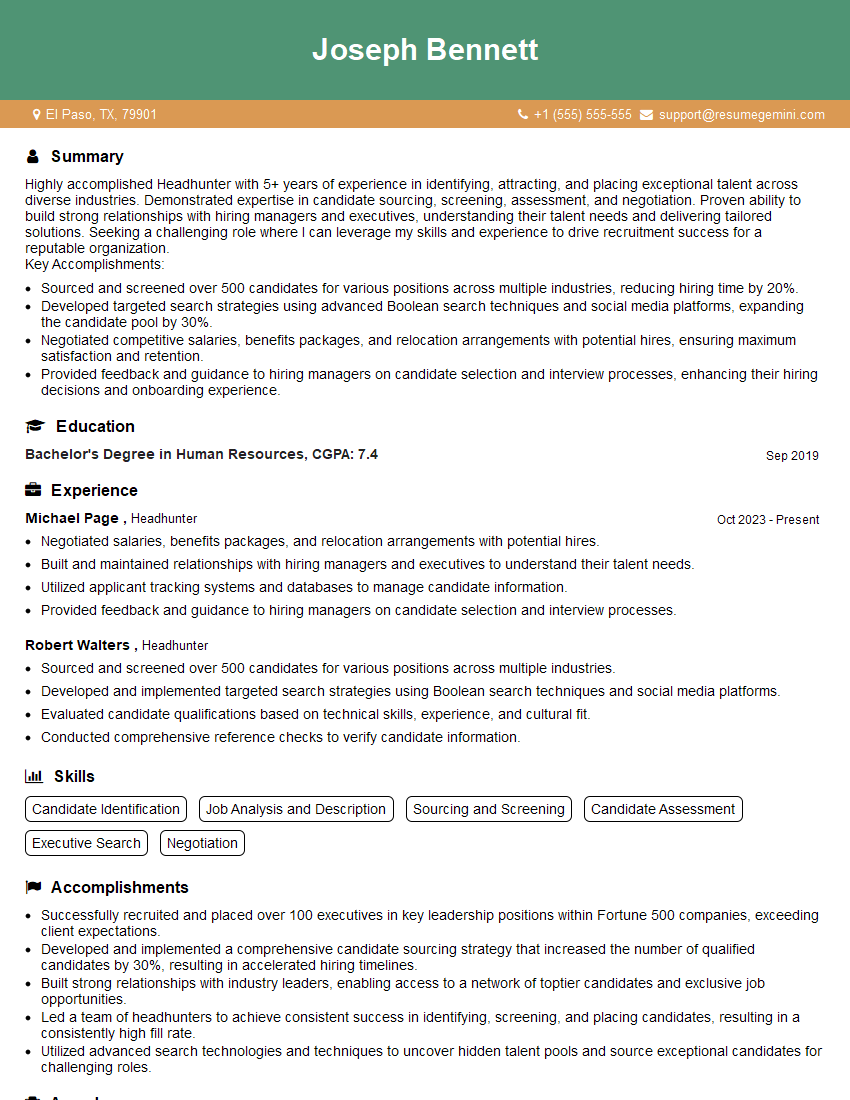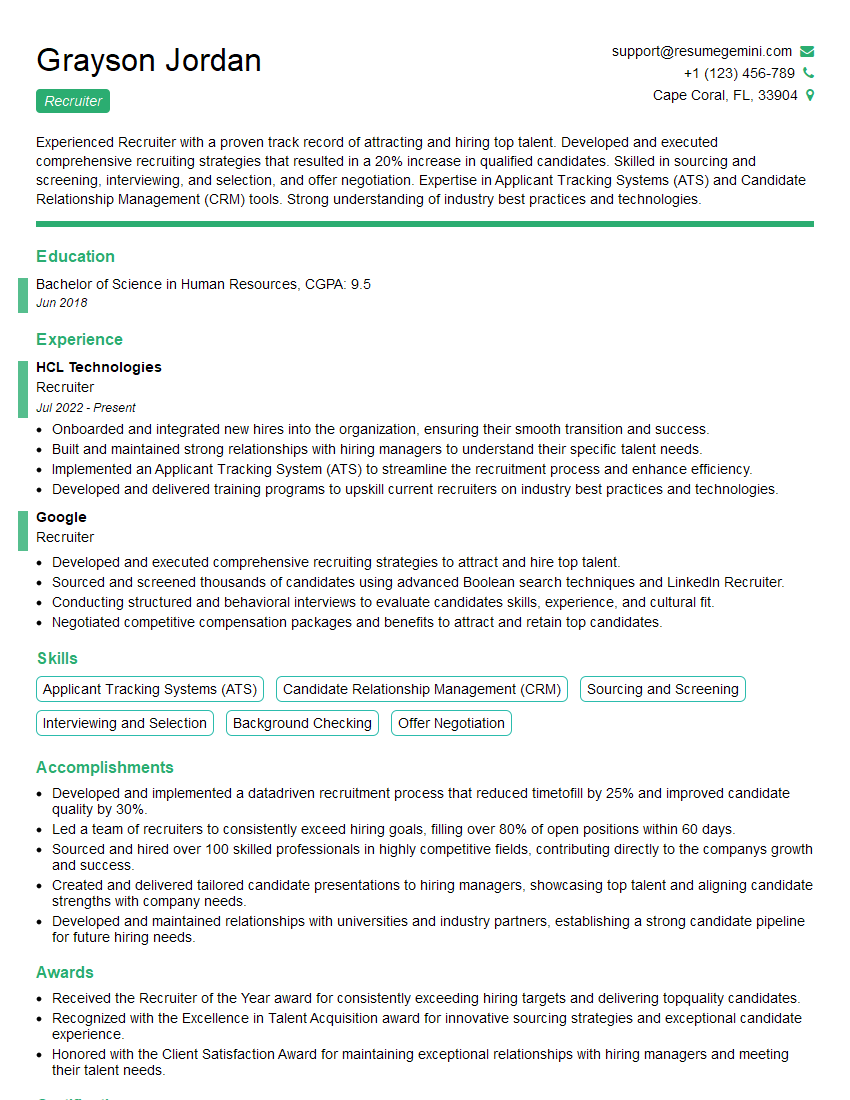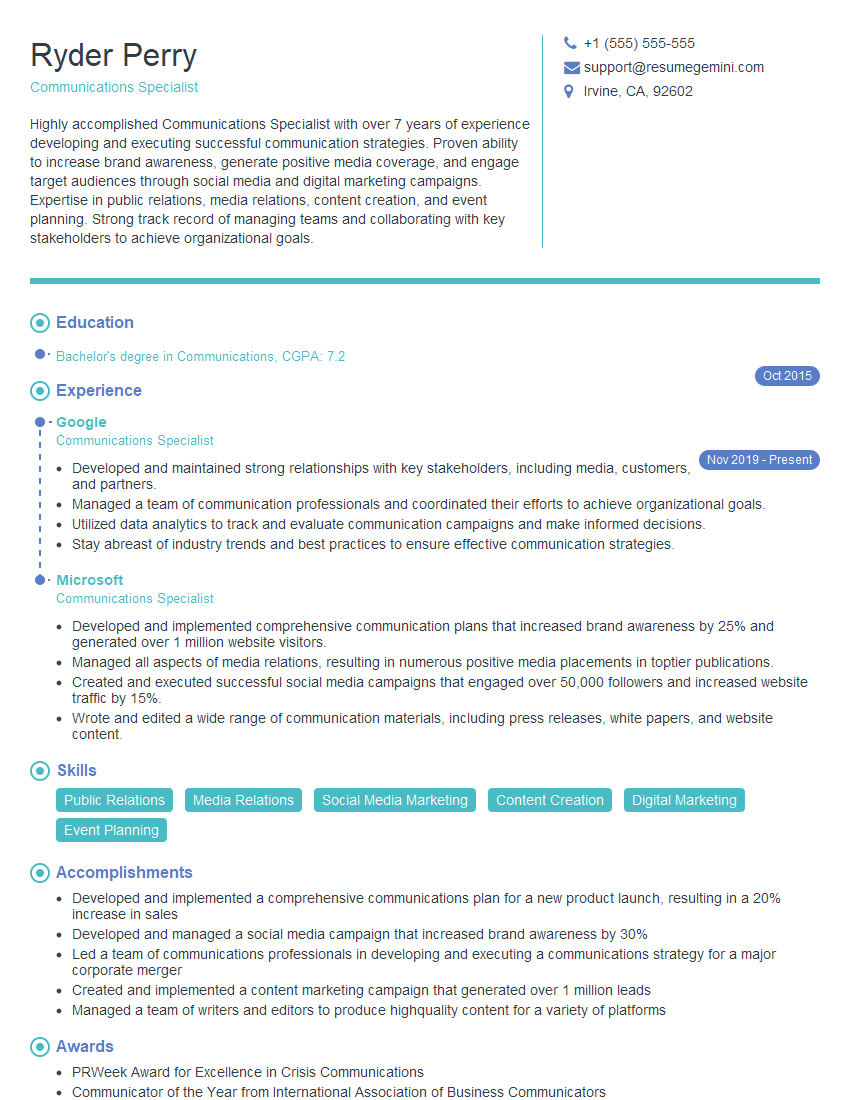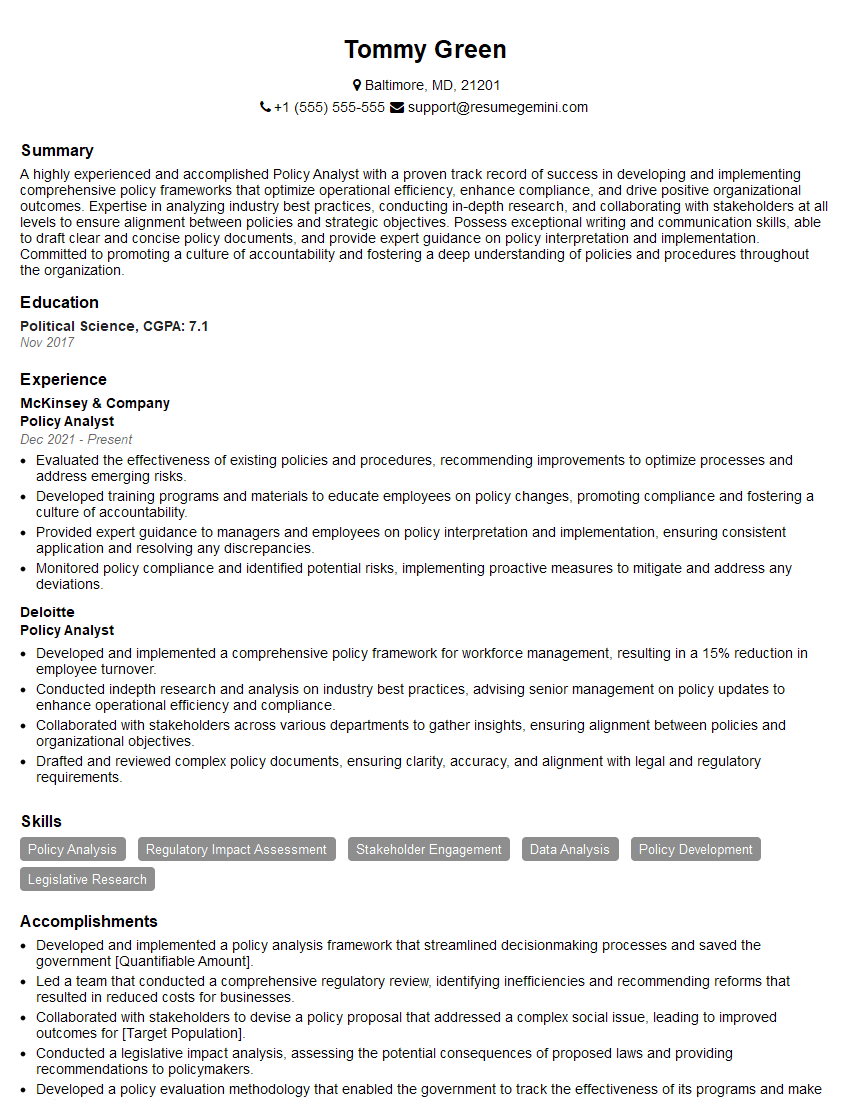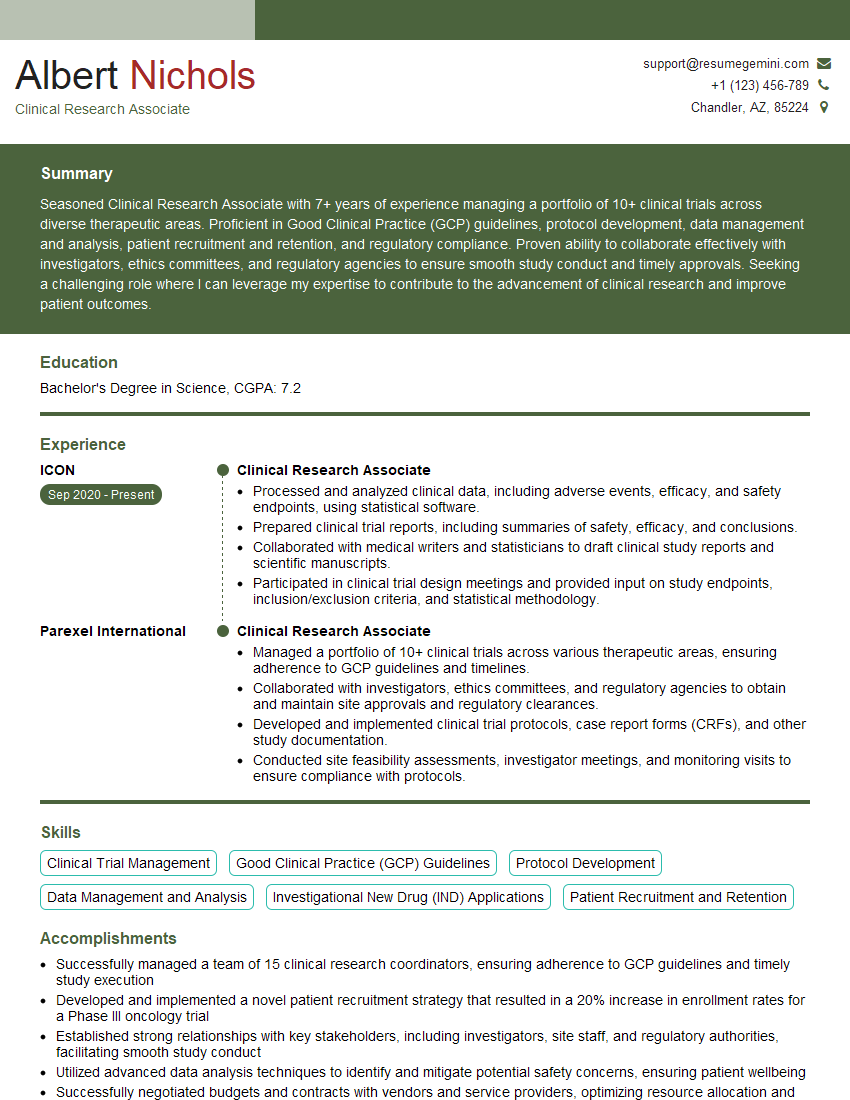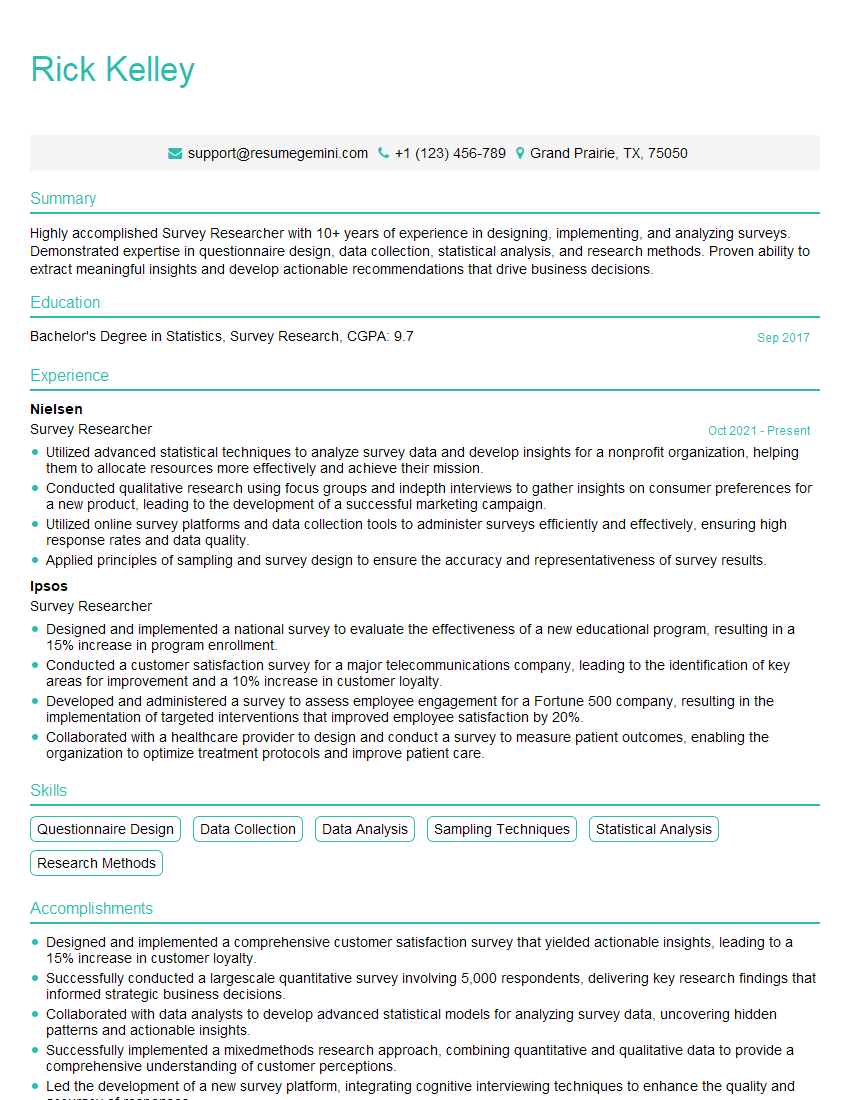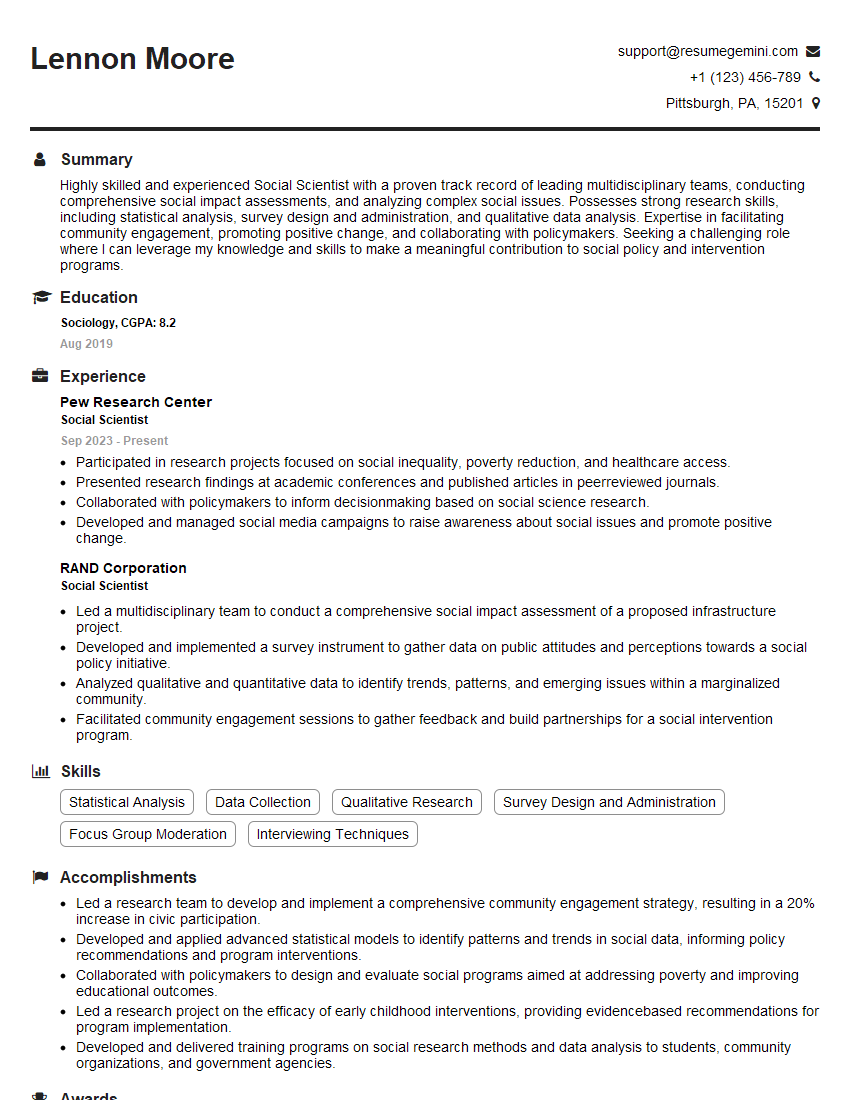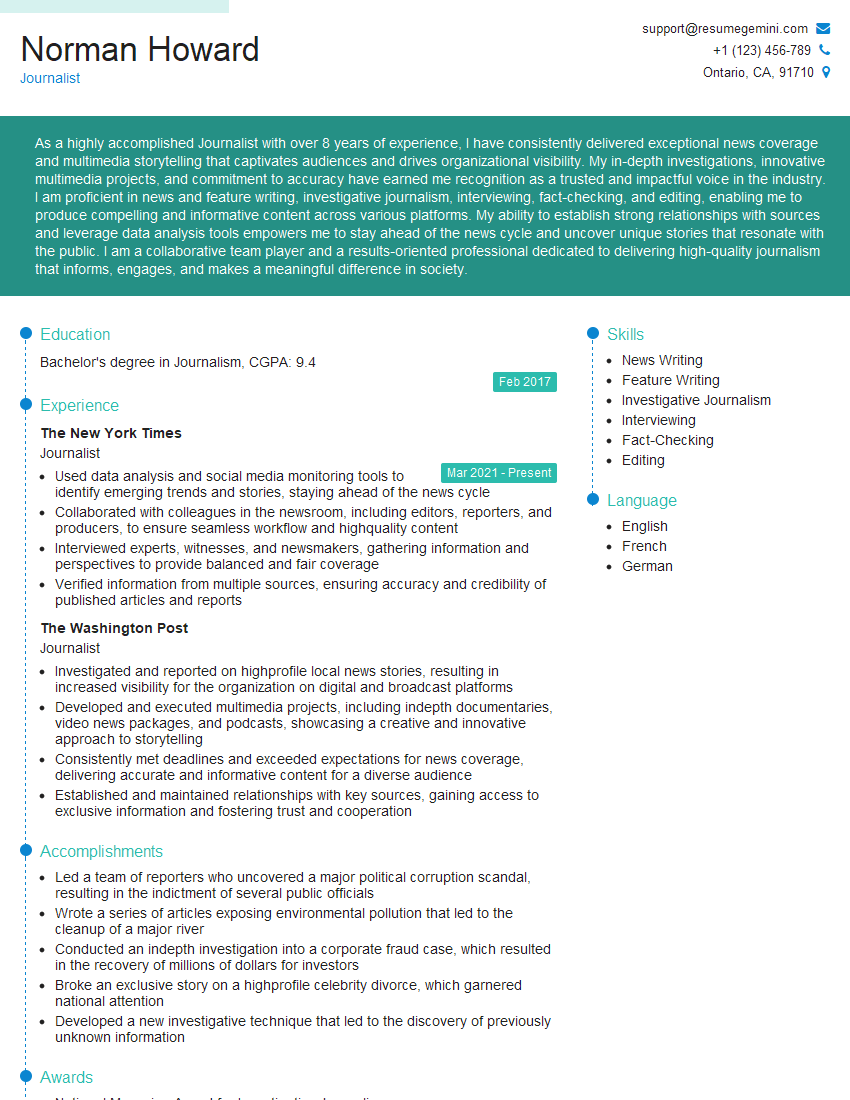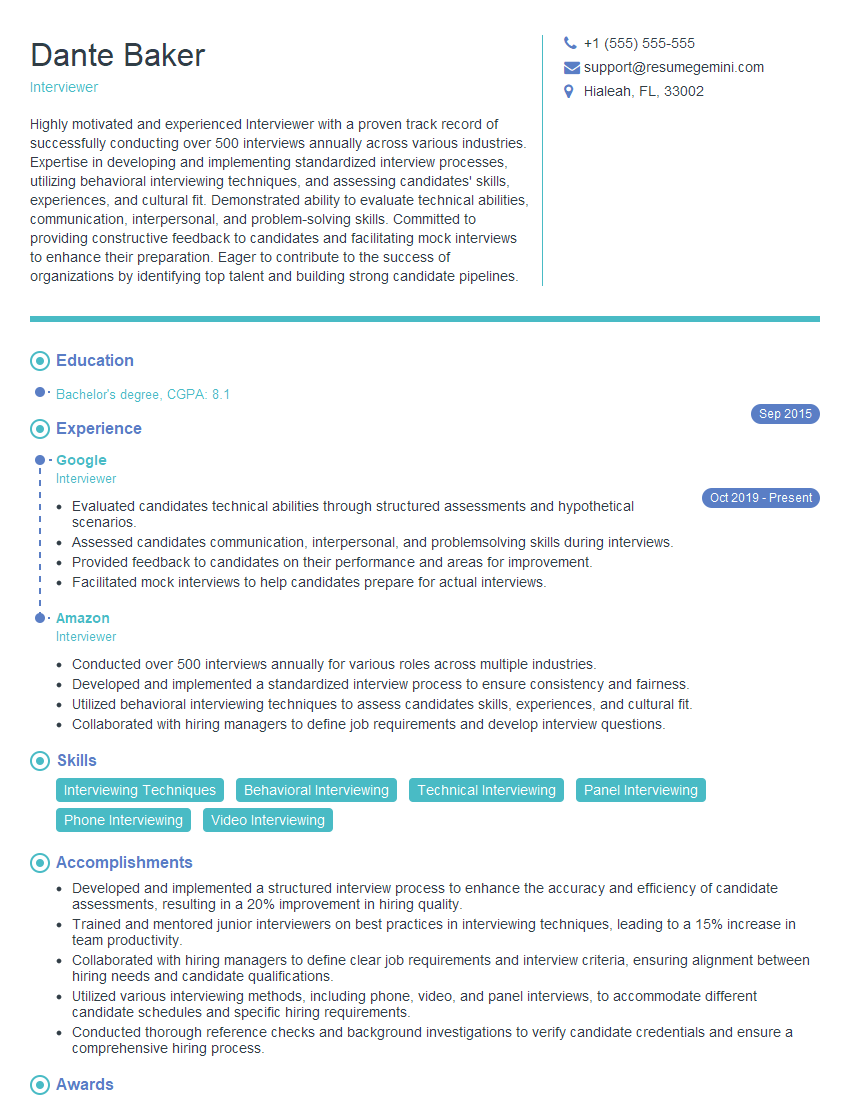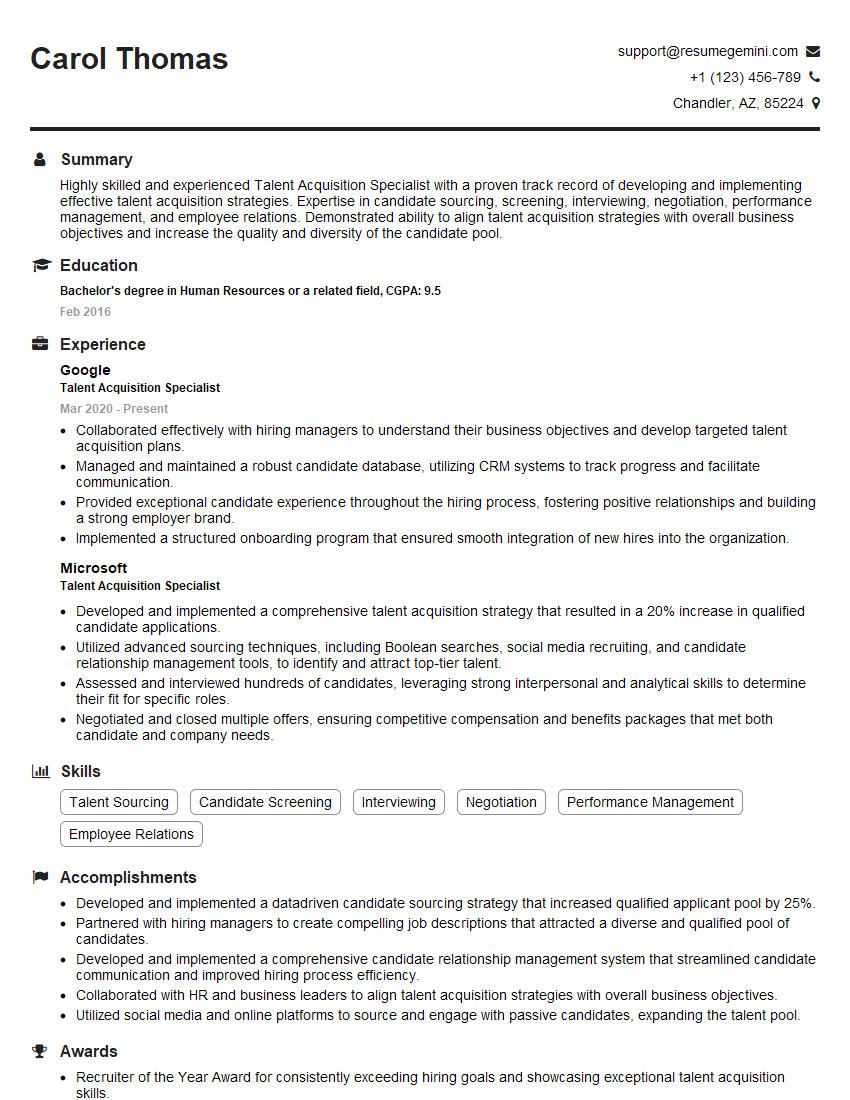Every successful interview starts with knowing what to expect. In this blog, we’ll take you through the top Interviewing and Research Techniques interview questions, breaking them down with expert tips to help you deliver impactful answers. Step into your next interview fully prepared and ready to succeed.
Questions Asked in Interviewing and Research Techniques Interview
Q 1. Define qualitative and quantitative research methods and their applications in interviewing.
Qualitative research explores the ‘why’ behind phenomena through in-depth understanding of experiences, perspectives, and meanings. It relies on non-numerical data like interviews, observations, and text analysis. Quantitative research, on the other hand, focuses on measuring and quantifying phenomena, using numerical data and statistical analysis to identify patterns and relationships. In interviewing, qualitative methods are used to gain rich insights into individual experiences and perspectives, while quantitative methods can be used to analyze interview data statistically, identifying trends and patterns across a larger sample.
Example: Imagine you’re researching employee satisfaction. A qualitative approach might involve conducting in-depth interviews to understand the nuances of employees’ feelings and experiences. A quantitative approach could involve surveying a large group of employees and analyzing the numerical responses to identify statistically significant correlations between factors like salary, workload, and job satisfaction.
Q 2. Explain the difference between structured, semi-structured, and unstructured interviews.
The three interview types differ significantly in their structure and flexibility:
- Structured Interviews: Employ a standardized set of pre-determined questions asked in a specific order. This ensures consistency across interviews and facilitates quantitative analysis. Think of a job interview with a pre-set list of questions for all candidates.
- Semi-structured Interviews: These use a guide with key questions and topics, but allow for flexibility in the order and wording of questions, and allow for follow-up probes based on the interviewee’s responses. This offers a balance between structure and exploration. Imagine a doctor’s appointment, where the doctor has a standard checklist of questions, but also explores symptoms and concerns based on the patient’s responses.
- Unstructured Interviews: Begin with a broad topic or question and allow the conversation to flow naturally, guided by the interviewee’s responses. These offer the greatest flexibility for exploring unexpected insights but require significant interviewer skill and can be challenging to analyze. A casual conversation about a project with a colleague might fall under this category.
Q 3. Describe the process of developing an interview guide for a specific research question.
Developing an interview guide involves a systematic process:
- Define your research question: Clearly articulate the central question your research aims to answer. For instance, ‘How do social media platforms influence the political attitudes of young adults?’
- Identify key themes and sub-themes: Break down your research question into smaller, manageable themes relevant to your research question. For our example, themes could be: platform use, information consumption, political engagement, and attitude formation.
- Develop open-ended questions: Craft questions that encourage detailed, thoughtful responses rather than simple ‘yes’ or ‘no’ answers. Avoid leading questions. Example: ‘Can you describe your typical social media usage?’ instead of ‘Do you use social media excessively?’
- Design probes: Prepare follow-up questions to delve deeper into interesting or unclear responses. For example, if someone mentions feeling influenced by online discussions, you might ask, ‘Can you tell me more about that influence?’
- Pilot test your guide: Conduct test interviews to identify any ambiguities, confusing questions, or areas needing improvement before your main study.
Q 4. How do you ensure the validity and reliability of your interview data?
Ensuring validity (accuracy) and reliability (consistency) is crucial. For validity, use multiple methods of data collection (triangulation), such as combining interviews with surveys or observations. Member checking involves sharing your interpretations of the data with interviewees to verify accuracy. For reliability, use a structured interview protocol, train interviewers thoroughly to minimize bias, and carefully document the interview process. Inter-rater reliability checks can be used when multiple interviewers are involved, comparing their interpretations of the same interviews.
Example: To validate findings on employee satisfaction, you might not only conduct interviews but also analyze employee performance reviews and absenteeism rates. To improve reliability, you would use a standardized questionnaire, ensuring all interviewers ask the same questions and follow the same procedures.
Q 5. What are some common biases in interviewing, and how can they be mitigated?
Several biases can affect interview data:
- Interviewer bias: The interviewer’s preconceived notions or leading questions can influence responses. Mitigation: Training interviewers in neutral questioning techniques and being aware of personal biases.
- Social desirability bias: Interviewees may give answers they believe are socially acceptable rather than truthful. Mitigation: Creating a safe and confidential environment, assuring anonymity, and using neutral language.
- Confirmation bias: Interviewers may selectively focus on information that confirms their existing beliefs. Mitigation: Employing a structured interview guide and actively seeking out contradictory information.
- Recall bias: Interviewees may have difficulty accurately recalling past events. Mitigation: Using memory aids (e.g., photographs, timelines) and focusing on specific timeframes.
Q 6. Explain the concept of sampling in research and its importance in interview studies.
Sampling is the process of selecting a representative subset from a larger population. In interview studies, careful sampling is essential for generalizing findings. Different sampling methods exist:
- Probability sampling: Every member of the population has a known chance of being selected (e.g., simple random sampling, stratified sampling). This allows for generalization to the larger population.
- Non-probability sampling: The probability of selection is unknown (e.g., convenience sampling, purposive sampling, snowball sampling). This limits generalizability but is often used when access to the entire population is impossible or impractical.
Importance: Appropriate sampling ensures that the interviewees’ experiences accurately reflect the broader population of interest. A poorly chosen sample can lead to inaccurate or biased results, making the research findings unreliable.
Q 7. Discuss different data analysis techniques used for interview data.
Various data analysis techniques are employed for interview data:
- Thematic analysis: Identifying recurring patterns and themes across interview transcripts.
- Content analysis: A systematic approach to quantifying the frequency of specific words, phrases, or concepts in the data.
- Narrative analysis: Focusing on the stories and narratives interviewees tell to understand their experiences.
- Grounded theory: Developing theories from data inductively; concepts and theories emerge directly from the interview data.
- Discourse analysis: Examining how language is used to construct meaning and power relationships.
The choice of technique depends on the research question and the nature of the data. Often, a combination of techniques is used to achieve a richer understanding.
Q 8. How do you handle sensitive or controversial topics during an interview?
Handling sensitive or controversial topics requires a delicate balance of empathy, professionalism, and ethical awareness. It’s crucial to approach these subjects with respect and sensitivity, ensuring the interviewee feels safe and comfortable sharing their experiences.
- Preparation is key: Before broaching sensitive subjects, carefully consider the potential impact on the interviewee. Develop a strategy for how you will approach the topic, including potential follow-up questions and ways to de-escalate if necessary. For example, if interviewing someone about a traumatic experience, start with broad, less intense questions to establish trust before delving into the specifics.
- Use neutral and unbiased language: Avoid judgmental or leading questions. Phrase questions objectively, focusing on the interviewee’s perspective and experience. Instead of asking, “Why did you do something so reckless?”, try, “Can you describe the circumstances that led to that decision?”
- Respect boundaries: If the interviewee appears uncomfortable or hesitant, immediately shift to a different topic. They have the right to decline answering certain questions. Acknowledge their discomfort and respect their boundaries. A simple, “I understand if you’re not comfortable discussing that,” can go a long way.
- Offer support resources: If the interview involves sensitive topics like abuse or trauma, make sure to provide contact information for relevant support organizations or hotlines. This demonstrates care and responsibility.
For example, during an interview about workplace discrimination, I might start by asking about their overall experience at the company, gradually leading to more specific questions about perceived bias, always being mindful of their comfort level. I would emphasize that their responses are valuable and confidential.
Q 9. What are the ethical considerations involved in conducting interviews?
Ethical considerations in interviewing are paramount, ensuring the process is fair, respectful, and protects the rights and wellbeing of the interviewee. Key considerations include:
- Informed Consent: Interviewees must fully understand the purpose of the interview, how the data will be used, and their rights to withdraw at any time. This often involves a consent form outlining these aspects.
- Confidentiality and Anonymity: Protecting the privacy of interviewees is crucial. Data should be handled securely, and identifying information should be anonymized whenever possible, unless the interviewee explicitly consents to its use.
- Avoiding Bias: Interviewers must strive to remain objective and avoid imposing their own biases on the interview process. This includes using neutral language and actively listening without interrupting or judging.
- Power Dynamics: Being aware of and mitigating any power imbalances between the interviewer and interviewee is essential. This might involve creating a relaxed and comfortable atmosphere, ensuring the interviewee feels empowered to express their views honestly.
- Data Security and Storage: Following data protection guidelines and storing interview data securely are critical, particularly when dealing with sensitive information. This often involves anonymization, encryption, and secure storage practices.
For instance, in a research interview, I would always provide a detailed informed consent form outlining the study’s aims, data usage, confidentiality measures, and the interviewee’s rights. I would also ensure all data is stored securely and anonymized for publication.
Q 10. Describe your experience with different interviewing software or tools.
My experience encompasses various interviewing software and tools, each with its unique strengths. I’ve used platforms for scheduling appointments, conducting remote interviews, and analyzing qualitative data.
- Scheduling tools (Calendly, Acuity Scheduling): These are invaluable for streamlining appointment scheduling, offering interviewees flexibility in choosing times that suit them.
- Video conferencing platforms (Zoom, Google Meet, Microsoft Teams): Essential for conducting remote interviews, these platforms facilitate communication across geographical boundaries and often include recording capabilities for later analysis.
- Transcription services (Otter.ai, Trint): These tools automate the transcription process, saving significant time and effort in analyzing interview data. This is particularly useful when working with large volumes of interview data.
- Qualitative data analysis software (NVivo, Atlas.ti): These sophisticated programs provide tools for coding, organizing, and analyzing qualitative data, assisting in identifying themes and patterns in interview transcripts.
For example, in a recent project, I used Calendly for scheduling, Zoom for conducting the interviews, Otter.ai for transcription, and NVivo for analyzing the resulting data. This integrated approach allowed for an efficient and effective workflow.
Q 11. How do you ensure informed consent from interviewees?
Ensuring informed consent is a cornerstone of ethical interviewing. This means the interviewee must fully understand what they’re agreeing to before participating.
- Detailed explanation: Clearly explain the purpose of the interview, how the information will be used, the duration of the interview, and the potential risks and benefits of participation.
- Written consent form: Provide a written consent form that summarizes this information, allowing the interviewee to review it carefully before signing. This form should include details about confidentiality, data storage, and the interviewee’s right to withdraw.
- Opportunity for questions: Allow ample time for the interviewee to ask questions and express any concerns. Answer all their questions clearly and honestly.
- Voluntary participation: Emphasize that participation is entirely voluntary and that there are no negative consequences for declining to participate or withdrawing at any point.
Think of it like signing a contract – both parties must fully understand the terms before agreeing. I always start with a clear explanation of the interview’s purpose and make sure the consent form is easily accessible and readily available in multiple languages where appropriate.
Q 12. How do you maintain confidentiality and anonymity of interviewees?
Maintaining confidentiality and anonymity requires meticulous attention to detail throughout the interview process and beyond.
- Data anonymization: Remove or alter identifying information such as names, addresses, and other personal details from the interview data. Use pseudonyms or codes to refer to participants in your reports or publications.
- Secure data storage: Store interview data securely using password-protected files, encryption, and secure cloud storage services. Restrict access to the data to only authorized individuals.
- Confidentiality agreements: Use confidentiality agreements to protect the privacy of interview participants. This is particularly important when dealing with sensitive information.
- Data destruction: After the research project is completed, securely delete or destroy the interview data unless otherwise required by law or regulation.
For example, in a study on sensitive health information, I would replace names with unique identifiers, encrypt the data, and store it on a secure server only accessible to the research team. I would clearly specify data usage and destruction protocols in my consent form and follow established data governance regulations.
Q 13. How do you manage time effectively during an interview?
Effective time management during an interview is crucial to stay on track and gather the necessary information efficiently.
- Structured interview guide: Create a detailed interview guide with pre-determined questions and time allocations for each section. This ensures you cover all key topics within the allotted time.
- Time awareness: Keep a close eye on the time throughout the interview, subtly reminding the interviewee of the time constraints if necessary.
- Prioritization: Prioritize the most important questions and focus on those first. If time runs short, you can always address less critical topics in a follow-up interview or survey.
- Concise questioning: Avoid lengthy or rambling questions; ask precise, clear questions to obtain direct answers.
I often start by informing the interviewee of the interview length and stick to the pre-defined timeline in my guide. If a particularly engaging topic arises, I’ll make a note to delve into it further in a follow-up session, ensuring I maintain the main interview’s structure and overall timeframe.
Q 14. How do you build rapport with interviewees?
Building rapport is essential for establishing trust and encouraging open communication. It’s about creating a comfortable and safe space for the interviewee to share their thoughts and feelings honestly.
- Active listening: Pay close attention to what the interviewee is saying, both verbally and nonverbally. Show genuine interest and empathy in their responses.
- Small talk and introductory conversation: Begin with some light, informal conversation to help break the ice and create a relaxed atmosphere. This can help put the interviewee at ease.
- Empathy and understanding: Show genuine empathy and understanding for the interviewee’s experiences and perspectives. Acknowledge their feelings and validate their points of view.
- Non-verbal cues: Use positive non-verbal cues, such as maintaining eye contact, nodding your head, and smiling appropriately, to demonstrate your engagement and attentiveness.
I often start by thanking interviewees for their time and sharing a brief, relatable anecdote to break the ice. I then actively listen and respond thoughtfully to their answers. This process helps create a connection and promotes trust, which leads to more detailed and insightful responses.
Q 15. How do you deal with an interviewee who is hesitant or unwilling to answer questions?
Handling hesitant interviewees requires sensitivity and skillful probing. It’s crucial to remember that their reluctance might stem from various factors, including discomfort with the topic, fear of judgment, or lack of trust in the interviewer. My approach is multifaceted:
- Building Rapport: I begin by creating a safe and comfortable environment. This includes establishing clear expectations about the interview’s purpose, ensuring confidentiality, and using empathetic language. A small, friendly conversation before delving into the core questions can often ease tension.
- Reframing Questions: If an interviewee hesitates, I may rephrase the question to make it less intimidating or more specific. For example, instead of asking, “What are your biggest challenges?”, I might ask, “Can you describe a specific situation where you faced a significant obstacle at work?”
- Offering Choices: Providing structured choices can help interviewees express their thoughts. For instance, instead of “How did you feel?”, I might ask, “Did you feel frustrated, overwhelmed, or something else?”
- Probing Gently: I use open-ended follow-up questions like “Can you tell me more about that?” or “What led you to that conclusion?” to encourage elaboration. It’s important to do this gently and avoid pushing for answers they’re not ready to share.
- Acknowledging Silence: I don’t rush to fill silences. Allowing moments of reflection can actually be beneficial. A simple “Take your time” can be incredibly reassuring.
- Respecting Boundaries: If, despite these efforts, the interviewee remains unwilling to answer a specific question, I respect their boundaries. It’s more important to maintain a trusting relationship than to force an answer.
For instance, in a recent study on employee burnout, one participant hesitated when asked about their emotional state. By rephrasing the question to focus on a specific workday event and assuring them of anonymity, they were able to open up and share valuable insights.
Career Expert Tips:
- Ace those interviews! Prepare effectively by reviewing the Top 50 Most Common Interview Questions on ResumeGemini.
- Navigate your job search with confidence! Explore a wide range of Career Tips on ResumeGemini. Learn about common challenges and recommendations to overcome them.
- Craft the perfect resume! Master the Art of Resume Writing with ResumeGemini’s guide. Showcase your unique qualifications and achievements effectively.
- Don’t miss out on holiday savings! Build your dream resume with ResumeGemini’s ATS optimized templates.
Q 16. Explain the process of transcribing and coding interview data.
Transcribing and coding interview data are crucial steps in qualitative research. Transcription involves converting audio or video recordings into written text, ensuring accuracy and capturing nuances like tone and emphasis. Coding is the process of systematically labeling segments of text with descriptive tags or codes that represent key themes or concepts.
- Transcription: I typically use professional transcription services for high accuracy, especially for complex or emotionally charged interviews. Manual transcription might be suitable for shorter interviews or when budget is constrained. It’s vital to verify the accuracy of the transcript and note any unclear sections.
- Coding: Coding can be done manually or with qualitative data analysis software (e.g., NVivo, Atlas.ti, MAXQDA). Manual coding involves reading through the transcript and identifying recurring themes or concepts. These are then assigned unique codes (e.g., ‘Job Satisfaction’, ‘Work-Life Balance’, ‘Leadership Style’). Software streamlines this process, allowing researchers to search, organize, and compare codes across multiple interviews.
For example, during a study on leadership styles, interview transcripts might be coded for themes like ‘delegation’, ‘communication’, ‘empowerment’, ‘decision-making’, etc. This coding process helps to identify patterns and make sense of the large amount of qualitative data.
Q 17. How do you interpret and synthesize findings from multiple interviews?
Interpreting and synthesizing findings from multiple interviews requires a systematic approach. The goal is to identify common patterns, recurring themes, and contrasting perspectives that emerge from the data.
- Identifying Recurring Themes: I start by reviewing the coded data from each interview, looking for common themes or concepts that appear repeatedly. This might involve creating a thematic matrix to organize the data.
- Comparing and Contrasting: Next, I compare and contrast the perspectives of different interviewees on each theme. This allows me to identify areas of agreement and disagreement, and understand the range of experiences within the study population.
- Developing Narrative Summaries: Based on the identified themes and perspectives, I construct narrative summaries that capture the essence of the interview data. This might involve creating case studies or summarizing key findings for each theme.
- Identifying Key Findings and Insights: The final step involves integrating the narrative summaries to identify overarching key findings and insights from the study. These should be presented in a clear and concise manner that supports the research objectives.
Imagine a study on customer satisfaction. By comparing coded data across multiple interviews, we might find that while most customers are happy with the product’s quality, a significant subset expresses concerns about customer service. This integrated analysis allows for nuanced conclusions, moving beyond simple summary statistics.
Q 18. What are the limitations of interview research?
While interviews offer rich qualitative data, they have limitations. It’s crucial to be aware of these limitations when interpreting the findings.
- Subjectivity: Interview data is inherently subjective, influenced by the interviewees’ perspectives, biases, and memory. The interviewer’s influence, including their questioning style and body language, can also impact responses.
- Small Sample Sizes: Interview studies often involve smaller samples compared to quantitative studies, limiting the generalizability of findings to broader populations.
- Interviewer Bias: The interviewer’s own preconceived notions and biases can inadvertently influence the questions asked and the interpretation of responses. Careful planning and reflexivity can help mitigate this.
- Social Desirability Bias: Participants might provide answers they perceive as socially acceptable, even if they don’t reflect their true thoughts or feelings.
- Time and Resource Intensive: Conducting, transcribing, and analyzing interview data requires significant time and resources.
For example, findings from interviews with a small group of employees might not accurately reflect the views of the entire organization. This limitation needs to be acknowledged when presenting the research results.
Q 19. How do you integrate interview data with other forms of research data?
Integrating interview data with other forms of research data can significantly enhance the richness and validity of findings. This process involves combining qualitative insights from interviews with quantitative data (e.g., surveys, experiments) or other qualitative data (e.g., observational data, document analysis).
- Triangulation: This involves using multiple data sources to confirm or refute findings. For example, interview data indicating low employee morale could be corroborated by quantitative data showing high turnover rates.
- Contextualization: Interview data can provide context and depth to quantitative findings. For example, survey data showing declining customer satisfaction could be enriched by interviews explaining the reasons behind this decline.
- Mixed Methods Approach: Researchers often adopt mixed-methods approaches that combine qualitative and quantitative techniques. Interviews might be used to explore the reasons behind quantitative findings or to generate hypotheses for further investigation.
In a study on the effectiveness of a new training program, for example, quantitative data might show improved test scores, while interview data could reveal participants’ perceptions of the program’s strengths and weaknesses, providing a holistic understanding of its impact. This combined approach helps to overcome the limitations of individual data sources.
Q 20. Describe your experience with conducting interviews in diverse settings or with diverse populations.
I have extensive experience conducting interviews in diverse settings and with diverse populations. Adaptability is key. My approach involves careful consideration of cultural nuances, communication styles, and potential power dynamics.
- Cultural Sensitivity: I am mindful of cultural differences in communication styles, including directness, nonverbal cues, and levels of formality. This involves adapting my questioning techniques and language to ensure the interviewee feels comfortable and understood.
- Language Accessibility: When working with populations who speak different languages, I utilize professional interpreters to ensure accurate communication and avoid misinterpretations.
- Building Trust: Establishing rapport is crucial, particularly with vulnerable populations. This involves demonstrating empathy, respect, and a genuine interest in their experiences.
- Power Dynamics: I am aware of potential power imbalances between the interviewer and interviewee and take steps to mitigate these. This might involve using less formal language, creating a relaxed atmosphere, and ensuring the interviewee feels in control of the conversation.
For example, in a research project exploring the experiences of immigrant women in a new country, I utilized bilingual interviewers and carefully tailored the interview protocols to account for potential cultural differences and sensitivities. This ensured participants felt heard and understood, which resulted in richer and more meaningful data.
Q 21. Explain the concept of triangulation in research and how it applies to interview studies.
Triangulation is a powerful research strategy that uses multiple data sources to validate findings. It enhances the credibility and reliability of research by reducing the reliance on a single source of data, which may be subject to biases or limitations.
- Data Source Triangulation: This involves using different data sources to address the same research question. For example, in an interview study on employee satisfaction, triangulation might involve comparing interview data with survey results and observational data from workplace visits.
- Investigator Triangulation: Multiple researchers independently analyze the data to ensure consistency in interpretation and minimize bias.
- Methodological Triangulation: This uses multiple research methods to investigate the same phenomenon. For example, combining interviews with questionnaires or experiments.
- Theoretical Triangulation: This involves using different theoretical frameworks to interpret the data, leading to a more comprehensive understanding.
In an interview study exploring the impact of a new policy on employee productivity, triangulation might involve comparing interview data with quantitative productivity measures and observations of workplace behaviour. By using multiple data points, researchers can gain a more holistic and robust understanding of the policy’s effect.
Q 22. How do you evaluate the credibility of sources during research?
Evaluating source credibility is crucial for reliable research. It involves a multi-faceted approach, assessing factors like authorship, publication, and content. Think of it like checking the ingredients before you bake a cake – you wouldn’t use expired flour, would you?
- Authorship: Who wrote it? What are their credentials? Are they experts in the field? Look for author bios, affiliations, and past publications to gauge their expertise and potential biases.
- Publication: Where was it published? Reputable journals and publishers undergo peer review, a process where other experts check the research for accuracy and validity. Look for established journals and avoid predatory open-access publishers.
- Content: Does the information align with established knowledge? Does the source provide evidence and citations to support its claims? Be wary of sources that make unsubstantiated claims or rely on anecdotal evidence. Look for clear methodology and data analysis in research articles.
- Currency: How recent is the information? In rapidly evolving fields like technology or medicine, older sources might be outdated. Consider the publication date and check for updated versions.
- Bias: Does the source show any obvious biases or agendas? Be critical of sources that promote a particular viewpoint without considering alternative perspectives.
For example, an article on climate change published in Nature by a leading climatologist would be considered more credible than a blog post on a personal website with no cited sources.
Q 23. How do you identify and avoid plagiarism in your research?
Plagiarism is presenting someone else’s work or ideas as your own. It’s academic dishonesty and can have serious consequences. Avoiding it requires diligent practice and understanding.
- Proper Citation: Always cite your sources, giving credit where it’s due. This includes direct quotes, paraphrases, and summaries. Think of it as giving directions – you need to clearly indicate where you got your information from.
- Quoting vs. Paraphrasing: Learn the difference between quoting (using the exact words) and paraphrasing (expressing the ideas in your own words). Both require citations. When quoting, use quotation marks; when paraphrasing, ensure you’ve truly rephrased the ideas and haven’t just changed a few words.
- Note-Taking Strategies: Keep meticulous notes when researching, clearly distinguishing between your ideas and those from other sources. Using a citation management tool can help track sources easily.
- Self-Plagiarism: Avoid reusing your own previous work without proper citation. This is also a form of plagiarism.
- Plagiarism Detection Software: Many universities use plagiarism detection software, so it’s crucial to avoid plagiarism from the start rather than relying on software to catch mistakes.
For instance, if you’re writing a paper on the effects of social media, you must cite any statistics or research findings you use from studies on this topic.
Q 24. How do you cite sources correctly according to a specific style guide (e.g., APA, MLA)?
Correct citation is essential for academic integrity. Different style guides (like APA, MLA, Chicago) have specific formatting rules. Learning the nuances of each is vital.
Let’s illustrate with APA style: Imagine you’re citing a journal article.
In-text citation: (Author’s Last Name, Year, page number).
Reference list entry:
Author, A. A. (Year). Title of article. Title of Journal, Volume Number(Issue Number), pages. DOI or URLFor example:
Smith, J. (2023). The impact of social media on adolescent mental health. *Journal of Adolescent Health, 72*(3), 250-260. https://doi.org/exampledoiMLA style differs; it uses author-page number in-text citations and a different reference list format. The key is to consult the style guide’s specific instructions carefully and consistently apply them throughout your work.
Using a citation management software like Zotero or Mendeley greatly simplifies the process of creating accurate citations and bibliographies.
Q 25. Describe your experience with using library databases or online research tools.
I have extensive experience with library databases (like JSTOR, EBSCOhost, PubMed) and online research tools (like Google Scholar). I’m proficient in using keywords, Boolean operators (AND, OR, NOT) to refine searches, and various search filters to narrow down results to relevant and credible information.
For example, when researching the impact of climate change on coastal communities, I utilized JSTOR and EBSCOhost to find peer-reviewed articles. I used keywords like “climate change,” “coastal erosion,” “sea-level rise,” and “community resilience.” Combining these keywords with Boolean operators helped me narrow my search to the most relevant articles. Google Scholar was also used to identify additional studies and related research.
Beyond search skills, I’m adept at navigating database interfaces, understanding citation formats, and evaluating the quality of results based on factors discussed earlier. I’m always learning about new tools and technologies to enhance my research efficiency.
Q 26. How do you critically evaluate research findings?
Critically evaluating research findings involves questioning the study’s methods, results, and conclusions. It’s not about simply accepting findings at face value but rather assessing their validity and reliability.
- Methodology: Was the research method appropriate? Were the samples representative? Were there any biases in the design or execution of the study? Look for methodological rigor.
- Results: Are the findings statistically significant? Are they presented clearly and accurately? Are there any limitations acknowledged by the researchers?
- Conclusions: Do the conclusions logically follow from the results? Are the interpretations justified? Are there alternative explanations that haven’t been considered?
- Context: How do these findings fit within the broader body of research in the field? Do they support or contradict previous findings? Consider the limitations of a single study in relation to the bigger picture.
For instance, while a study might show a correlation between two variables, it doesn’t necessarily imply causation. Critical evaluation would involve looking for confounding factors or alternative explanations for the observed correlation.
Q 27. Explain your experience with designing and implementing research projects.
My experience in designing and implementing research projects includes formulating research questions, developing methodologies, collecting and analyzing data, and writing reports. I have worked on both quantitative and qualitative research projects, adapting my approach to suit the research question and available resources.
The process typically involves:
- Defining the Research Question: Clearly articulating the research problem and formulating a specific, measurable, achievable, relevant, and time-bound (SMART) research question.
- Literature Review: Conducting a thorough review of existing literature to understand the current state of knowledge and identify any gaps.
- Methodology Selection: Choosing the appropriate research methods (e.g., surveys, experiments, interviews, case studies) based on the research question and resources.
- Data Collection: Implementing the chosen methods to collect data rigorously and ethically.
- Data Analysis: Analyzing the data using appropriate statistical or qualitative methods to answer the research question.
- Report Writing: Presenting the findings clearly and concisely, including limitations and implications of the research.
I’m comfortable using various software packages for data analysis, such as SPSS and NVivo, depending on the type of data.
Q 28. Describe a challenging research project and how you overcame the challenges.
In a recent project investigating the effectiveness of a new educational intervention, we encountered difficulties in recruiting a representative sample of participants. Our initial target population was geographically dispersed and had varying levels of technology access, leading to low response rates and sampling bias.
To overcome this, we implemented a multi-pronged strategy:
- Adjusted Recruitment Methods: We diversified our recruitment methods, including utilizing social media, community partnerships, and direct outreach to specific groups within the target population.
- Incentivized Participation: We offered incentives to participants to encourage participation and address barriers to engagement.
- Modified Data Collection Tools: We adapted our data collection tools to be more accessible, including providing materials in different formats and offering assistance with online survey completion.
- Statistical Adjustments: During data analysis, we used statistical techniques to account for the potential bias introduced by our non-representative sample.
Although the initial challenges posed a significant hurdle, these adjustments improved our recruitment process, resulting in a more representative sample and more robust research findings. This experience underscored the importance of flexibility and adaptability in research.
Key Topics to Learn for Interviewing and Research Techniques Interview
- Structured Interviewing: Understanding the principles of structured interviews, including developing unbiased questions and consistent scoring methods. Practical application: Designing interview guides for specific roles, ensuring fairness and objectivity.
- Unstructured Interviewing: Mastering the art of open-ended questioning and active listening to gain deeper insights into a candidate’s experience and personality. Practical application: Adapting your questioning style to elicit detailed responses and evaluate soft skills.
- Behavioral Interviewing Techniques: Learning to effectively ask behavioral questions (e.g., STAR method) to assess past performance and predict future behavior. Practical application: Analyzing candidate responses to identify patterns and evaluate their problem-solving abilities.
- Qualitative Research Methods: Understanding different qualitative research approaches (e.g., focus groups, interviews, case studies) and their application in gathering rich data. Practical application: Designing and conducting research studies to inform strategic decisions.
- Quantitative Research Methods: Familiarity with basic quantitative research methods (e.g., surveys, experiments) and their use in evaluating data objectively. Practical application: Analyzing survey results and drawing conclusions to inform recruitment strategies.
- Data Analysis and Interpretation: Developing skills in interpreting research findings and drawing meaningful conclusions. Practical application: Presenting research findings clearly and concisely to stakeholders.
- Bias Mitigation in Interviewing and Research: Identifying and addressing potential biases in interview processes and research methodologies. Practical application: Implementing strategies to ensure fair and equitable selection processes and research outcomes.
Next Steps
Mastering Interviewing and Research Techniques is crucial for career advancement, opening doors to leadership roles and specialized research positions. A strong understanding of these techniques demonstrates your ability to make informed decisions, manage teams effectively, and conduct robust research. To significantly boost your job prospects, it’s essential to create an ATS-friendly resume that highlights your relevant skills and experiences. We highly recommend using ResumeGemini to build a professional and impactful resume tailored to your specific goals. ResumeGemini provides helpful tools and resources, and even offers examples of resumes tailored to Interviewing and Research Techniques to guide your process. Take the next step towards your dream career today!
Explore more articles
Users Rating of Our Blogs
Share Your Experience
We value your feedback! Please rate our content and share your thoughts (optional).
What Readers Say About Our Blog
Hello,
We found issues with your domain’s email setup that may be sending your messages to spam or blocking them completely. InboxShield Mini shows you how to fix it in minutes — no tech skills required.
Scan your domain now for details: https://inboxshield-mini.com/
— Adam @ InboxShield Mini
Reply STOP to unsubscribe
Hi, are you owner of interviewgemini.com? What if I told you I could help you find extra time in your schedule, reconnect with leads you didn’t even realize you missed, and bring in more “I want to work with you” conversations, without increasing your ad spend or hiring a full-time employee?
All with a flexible, budget-friendly service that could easily pay for itself. Sounds good?
Would it be nice to jump on a quick 10-minute call so I can show you exactly how we make this work?
Best,
Hapei
Marketing Director
Hey, I know you’re the owner of interviewgemini.com. I’ll be quick.
Fundraising for your business is tough and time-consuming. We make it easier by guaranteeing two private investor meetings each month, for six months. No demos, no pitch events – just direct introductions to active investors matched to your startup.
If youR17;re raising, this could help you build real momentum. Want me to send more info?
Hi, I represent an SEO company that specialises in getting you AI citations and higher rankings on Google. I’d like to offer you a 100% free SEO audit for your website. Would you be interested?
Hi, I represent an SEO company that specialises in getting you AI citations and higher rankings on Google. I’d like to offer you a 100% free SEO audit for your website. Would you be interested?
good



